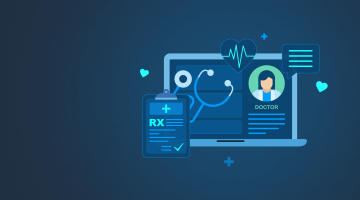

Life insurance software product development process: Full guide
Today, companies providing life insurance coverage tend to have high-level services backed by a robust software system. Modern people don’t want to spare their time on emailing, calling, or visiting their agents. They need clear and user-friendly systems that allow them to get relevant services online. Thus, along with new policies, products, and pricing, companies modernize or build brand-new insurtech platforms. In this article, you can learn more about the life insurance software product development process and its peculiarities.
Need assistance in the insurance product launch and relevant software implementation? Learn more about our services.
Essential knowledge: What is a life insurance product? Insurance product life cycle
According to AccuQuote, there are two types of life insurance products: term and permanent. Both types have different subtypes to satisfy different needs. The permanent type provides coverage for as long as you need it. There are many kinds of permanent life insurance, but the key categories include whole life and universal life.
Term life insurance is temporary insurance that may typically last for 10-30 years. It can provide coverage for only a limited period of time. The policies are quite clear and usually cheap. Insurance companies, as a rule, guarantee that each year you will pay the same cost for your coverage. The rates may vary from $25 to $200 per month. Once your term comes to an end, you will get notice of the increased costs of life insurance.
When comparing two types of insurance, we may admit that universal life and whole life cost more than temporary insurance. Unlike term, permanent insurance lasts forever. As long as you pay your premiums, your family members are guaranteed to get the death benefit, no matter when you die. Permanent insurance provides cash value which may be accessed at any time for any reason.
As insurance agencies strive to become more flexible to meet ever-changing market demand and conditions, they constantly look for innovation and ways to improve their products. In terms of better services and products, these companies usually choose two ways. Firstly, they can provide better services and products for their customers with the help of new software. Secondly, they can design new types of insurance products.
Before proceeding to software solutions, let’s talk about the traditional insurance life cycle. Usually, people may plan their life insurance according to definite periods of their lives. Thus, according to Lenox Advisors, there are the following stages of the life insurance cycle.
Rethink risk assessment processes by implementing custom insurance risk management software.
Stages of the life insurance cycle
25-35 year-old clients – starting a career and/or marriage – during this period of life, people need the highest level of insurance, which covers basic protection like life value and general family income
35-45 year-old clients – growing income and/or family – at this stage, people usually need insurance for business planning purposes like buying/selling, deferred compensation, business succession, etc. It also comprises tax-advanced strategies, private placement life insurance, and access to an increase in policy cash value, etc.
45-55 year-old clients – estate/retirement planning includes retirement planning strategies, whole life, supplemental retirement stream, asset, and creditor protection.
55-64 year-old clients – highest earnings/taxes – charitable giving, planned giving, charitable lead trust.
65+ year-old clients – estate planning – estate equalization, liquidity to offset, special needs children planning.
What software do insurance companies use? Types, features, benefits
If you own an insurance agency or company, you probably know that there are two types of software — prepackaged and custom-designed. The former type is usually built for sale to any company to serve a great number of users. The latter type is typically built especially for one single company that needs a completely customizable solution. Unlike custom software, prepackaged systems cannot be as customized individually as bespoke systems.
Both, ready-made/prepackaged software and custom-designed software, have pros and cons, so at the end of the day, you should choose a system which meets your requirements better.
- Ready-made. Preprogrammed applications come with fixed functions and few customization opportunities. They will be good for traditional businesses but rarely meet the requirements of very small (due to extra unnecessary tools) or too large corporations (due to low uniqueness) businesses.
- Custom software programs are made from scratch for each customer. Developers can add any desired module to meet all needs. Custom apps are perfectly customizable and more profitable in the long run, but they require a good vision of your company’s goals.
The privilege of bespoke software is its unique set of features and functionalities that face users’ needs and requirements. When you create a system from scratch, you can get as many features as you need. And what is more important is that you can get only those features your users need. Let’s take a closer look at the core features your life insurance software should have.
Feature 1 – Life insurance product definition module
This feature is aimed to provide a definition of new products, edit and modify the existing definition, and store and transfer product data.
Feature 2 – Policy management
This feature is designed to manage group or individual policies. It provides capabilities to register applications, assess risks, present information, modify insurance conditions, handle claims, etc.
Learn more: Insurance policy management software development services.
Feature 3 – Fund management
This feature ensures automatic reports/order generation and offers the following options: accounts management, operations, order handling, fund registries, etc.
Feature 4 – Accounting and finance
This feature is designed to categorize different events (taxable/non-taxable). It offers reminders of premium underpayment or nonpayment, cash flow management, and other important options.
To understand what other features you can get with custom development, let’s take a look at Insubiz company. Our company developed a fully customizable solution that offers a lot of options for its users:
- CRM
- Assets
- Claims
- Risks
- Reports
- Analysis
The solution is extra user-friendly as it meets all the initial wants and needs of all the stakeholders. Insubiz is easily implemented and provides fast support and regular updates. As you can see, bespoke platforms can ensure more functionalities and options for their users compared to prepackaged ones.
With a well-built system in place, you can enhance customer service and support, manage big data, and create large client databases. Custom-designed software can also automate data processing, sharing, and analyzing. Automation eliminates human errors and makes insurance processes more efficient and streamlined. All the information is kept in one system and easily accessible.
Here are more success stories of insurance software development by our experts:
- Applications for BriteCore’s P&C insurance core platform
- Updated INSIS application for Fadata
- RiskVille cloud solution for risk and insurance management
Stages of the life insurance software cycle
By realizing how things work during SDLC, managers and stakeholders can improve their vision and modify requirements. Say, initially, a team of underwriters desired an all-in-one package with advanced catalogs and enterprise-grade accounting software. But after discussing plans with developers (step #1), exploring business analysis (step #2), and receiving an MVP with only basic tools (step #4), employees realized that they don’t need other costly extensions. As a result, this company was successful in getting higher ROI.
This means it’s always better to know about something rather than not. Keeping this statement in mind, let’s look at the insurance product development stages.
Life insurance software product development process
1. Planning
The first phase is fully theoretical as it includes all the possible plans, estimations, and evaluations. During the planning stage, managers, stakeholders, key users from all the company’s departments, and developers discuss how the project will go on. Here, you should define the location of resources, the project scope and goals, schedules, budgets, requirements for the QA team, and potential risks. As a result, the first sketch will be ready.
2. Analyzing
Further, all the mentioned things must be discussed once again with in-house or external analysts. These experts can help if you don’t clearly understand the software requirements or market conditions. Results of analytical work are processed and concluded in the form of the SRS – Software Requirement Specification document, which will be the main guideline for developers. Agile teams may have several SRS samples for each iteration.
3. Designing
Using the mentioned requirements, product authors design an architecture, make prototypes and deploy them to show how they work. Developers focus on both high-level design with features, modules, and interfaces and on low-level one with databases, functional algorithms, and code itself. At the end of this step, clients get one or a few DDS – Design Document Specifications which describe the product in detail.
4. Creating
The longest stage covers the health insurance product development itself. Coders use DDS as the guide and the chosen languages/frameworks as tools. Waterfall methodology doesn’t provide too many options for reviews and control on the client side, but Agile approaches are more flexible and allow you to leave feedback during each sprint. However, significant changes aren’t desirable during this process.
5. Testing
Modern SDLC models include small testing tasks for each step, but this conclusion is required, as well. Here, QA experts analyze the software performance, check code quality, and perform various tests focused on functional areas, integrations, security, etc. Developers then fix bugs or change modules and send the product back to the QA team for re-test. The next phase can begin only when the software complies with SRS papers fully.
6. Deployment
The most recent applications can be installed nearly instantly because of the high level of automation. If preparation measures were taken properly and no bugs were found, the deployment is a question of a formal launch, not more. To avoid issues, you want to install an MVP beforehand and look at how this basic product will work. Additionally, take care of data migration and keep core processes untouched during the launch.
7. Maintenance
After the deployment, you can choose among various options:
- Refuse extra services. Thus, your in-house employees will be required to handle all updates, fixes, and enhancements.
- Get trial support. Here, developers will help with tech support and maintenance for a specific period, e.g. one week or one year.
- Get lifelong support. In this case, the development team will provide support and maintenance without limitations.
- Choose continuous development. The most advanced option includes various updates and upgrades in addition to tech support services.
Need a custom solution? Consider custom insurance mobile app development.
Key roles and responsibilities in SDLC
At first glance, it seems that a seven-step process is very simple. Keep in mind, though, that dedicated developers put a lot of effort into the development process, especially if projects are long-term.
Of course, you can buy an off-the-shelf product with a ready set of features. However, if you need a customizable solution, consider a custom insurance product design.
Besides, anybody in need of a life insurance product can choose between in-house development and outsourcing. Let’s compare these alternatives.
If you are interested in hiring a dedicated team, learn more about DICEUS.
How to launch a new insurance software product
Today, insurance companies face a lot of challenges such as regulatory compliance, cyber-attacks, data skills gap and shortage, rate increases and inflationary pressures, and many more. Therefore, all insurance carriers need effective IT solutions to manage their operations and improve customer engagement. Thanks to modern technologies, it is possible to eliminate redundant and manual jobs, decrease paperwork, and even make tariffs lower.
Understanding the challenges, most companies simply don’t know where to start. DICEUS recommends starting with hiring the right software development vendor with expertise in software product development in insurance. You will be able to discuss all the concerns and challenges your company has right now and explain what goals you want to gain with a new solution.
Here, at DICEUS, we adhere to the following best practices in insurance product implementation:
- Focusing on user and customer experience (UX/CX)
- Building omnichannel CX systems
- Developing user journey maps and customer personas
- Implementing data analytics and reporting
- Automating claims processing
- Implementing innovative functionalities, e.g., image/video/voice recognition
In this article, we offered responses to some of the most frequent questions about the life and medical insurance product development process. You know what types of products are offered in the market, what types of software insurance agencies use, and what features are crucial to have. Yet, if you need to get more detailed information about how to improve your existing systems or modernize legacy software, we are here to help you.
FAQ
What are the key stages of the life insurance software product development process?
The main stages of life insurance software product development include business analysis (discovery phase), software architecture and design, development, testing, deployment, launch, and support. In case an insurance carrier needs additional features later, maintenance is provided.
What are the challenges in developing life insurance software products?
The key challenges usually include the lack of understanding of the insurance business and its processes, poor understanding of business goals, gaps between functionalities and customer needs, and more. To develop an effective solution, a software vendor should conduct a business analysis to clearly understand business needs and challenges they would like to address with the help of a particular software product.
How can the Agile methodology be applied to life insurance software product development?
Agile methodology is based on 2-week periods with different tasks for each. The model provides for continuous development, which begins with an MVP and then adds more functions to the product regularly. Plus, a client can leave feedback during each sprint.
How important is user experience (UX) design in life insurance software product development?
User experience is paramount for every software product used in insurance, either a simple chatbot or a sophisticated web portal. Designers should consider user personas and user journeys to create user-friendly experiences and interfaces for all customer segments.
How can life insurance software product development be aligned with business goals and objectives?
Defining business goals is probably the first step of the discovery phase. It is one of the important things because only knowing the objectives can developers offer the right solution. For example, if the company’s goal is to decrease paperwork, developers would suggest implementing special tools like OCR (optical character recognition) for better document processing.





